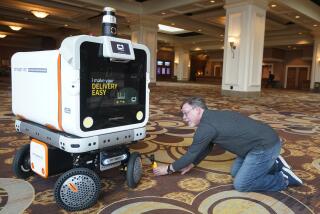Trade Show Fare Leaves Stomachs Growling : Electronics: Retailers hungry for new gadgets will find little that’s exciting. Home-office products could be a bright spot, though.
- Share via
SAN FRANCISCO — The consumer electronics industry, hungry for major new products that might restore the double-digit growth rates of the early 1980s, will get only an unsatisfying nibble of the future at its semiannual trade show, which begins Thursday in Las Vegas.
Two of the most exciting new products to be shown at the Consumer Electronics Show--a new type of cassette tape player from Philips and a new model of the Nintendo video game system--will only be demonstrated at the show, not formally introduced.
A potentially important product that last year seemed poised for a major takeoff--the digital audiotape recorder--is still the subject of legal wrangling and hasn’t been a hit with consumers.
And several product categories with enormous long-term potential--advanced television sets and home automation systems--are hanging in limbo until agreement can be reached on technical standards. All this has left stomachs growling among consumer electronics retailers.
“There’s nothing terribly exciting, nothing refreshingly new or different,” laments Robert B. Miller, vice president for merchandising at the huge Radio Shack retail chain. “And the industry could sure use something.”
The general economic situation hasn’t done much for the mood either. The sluggish economy resulted in weak Christmas sales for many consumer goods. The Electronic Industries Assn., which sponsors the show, predicts that the $33-billion consumer electronics industry will grow just 3% this year, a far cry from the double-digit growth rates of the 1970s and early 1980s.
Still, electronics vendors can take heart from several long-term trends. The growth of the home-based office should continue to boost sales of items such as fax machines, personal copiers and cordless telephones. And it could help break open the elusive home market for desktop computers.
The exhibit space devoted to home-office equipment is up 30% this year, according to EIA spokeswoman Cynthia Upson. And International Business Machines is exhibiting at the CES show for the first time, as part of its effort to position the PS/1 personal computer as a true home computer.
“The border between commercial products and consumer products is dissolving,” says James I. Magid, an analyst with Needham & Co. in New York. He predicts that the hottest product at the show will be video laser disc players, an alternative to VCRs. The video discs, which are used to record movies, are similar to those that are increasingly used as storage devices on business computer systems.
In addition, incremental improvements in the performance of a wide range of consumer electronics products, made possible by sophisticated new computer techniques such as “fuzzy” logic and digital signal processing, promise to prop up demand even in established markets.
Video cameras that automatically compensate for movements of the hand, drying machines that can tell when the clothes are dry, and car stereo systems that can be adjusted to reproduce the acoustics of Carnegie Hall or the Coliseum are just a few examples of this phenomenon.
In the bread-and-butter category of audio/video, moreover, the demand for bigger and better systems at the high end of the market continues unabated. The latest buzzword is home theater, which refers to expensive, custom-installed stereo and big-screen video systems.
Paul Gluckman, managing editor of the trade journal Audio Week, says home theater could provide a way for specialty electronics retailers to ride out the recession. “These sales are not as dependent on the vagaries of store traffic, and you’re not competing with the guy down the block on price,” he says.
Big-screen televisions, and a variety of new TVs that use special computer chips to provide much improved pictures, also provide a good transition product for manufacturers who are awaiting the emergence of high-definition television. The era of HDTV is expected to begin in 1993, after the Federal Communications Commission chooses a standard.
In the video game category, Sega is introducing a hand-held game to compete with Nintendo’s highly successful Game Boy. But most eyes will be on Nintendo, which controls more than 90% of the video game market, despite stepped-up competition from Sega and Japan’s NEC.
Sega and NEC have tried to break the Nintendo monopoly with game systems that offer 16-bit color and graphics, which are far superior to Nintendo’s eight-bit color. But Nintendo is already selling a 16-bit system in Japan, and that system will be on display at CES--though Nintendo is coy about when it will be introduced in the United States.
A new Nintendo machine--and the new generation of game cartridges that would accompany it--could spur a new boom in video game sales. And Nintendo may also reveal more details of how it hopes to exploit the non-game computer capabilities of its ubiquitous home entertainment system.
The wait for the new Philips tape recorder, being developed in conjunction with Tandy Corp., is likely to be much longer. The Dutch electronics company announced last year that it had developed a digital tape recorder that, unlike existing DAT systems, can play traditional magnetic tapes. That would give consumers the sound quality of a compact disc while preserving their investment in standard cassettes.
If the system works as advertised, it could displace DAT as the next wave in audio equipment. But though the digital compact cassette, as it is known, will be demonstrated at CES, Philips says it is still two years away from commercial roll-out.






